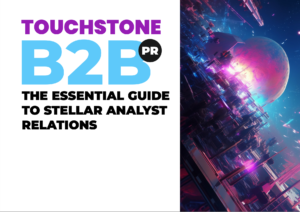
Analyst Relations – where do I begin?
As a tech start-up or scale-up, you may be wondering how to approach industry analyst relations (AR), a practice of relationship building in the tech industry that is seemingly (but only seemingly) the preserve of large vendors.
True, you do need a strategic resource, and to invest time and effort in developing relationships with analysts – the expert advisers on how, where and why IT-related products and services are bought and used. There is no reason though why a growing tech company could not establish mutually beneficial relationships with industry analysts and gain their mindshare.
So, what are the first and essential steps towards successful AR? Read our top tips below.
Securing executive buy-in and ‘selling’ AR within your organisation
An analyst relations programme will require a cross-departmental effort as well as support from senior executives who will also act as analyst relations spokespeople. Securing financial investment and investment of time and effort by senior executives and product managers is key.
The first step is to eliminate the misconception that analysts are just a more ‘corporate’ version of journalists and can be ‘covered’ by PR. Too often, analyst briefings are tagged onto press days or, worse still, analysts are invited to executive briefings when the response from journalists is low.
Industry analysts require a dedicated, strategic and sustained effort that is managed by AR professionals who have the required tools, know-how and access to executives and product managers in order to be able to drive a strong AR programme. This is the only way to ensure analysts receive the right information (with an appropriate level of detail) at the right time and through appropriate channels.
AR training for spokespeople
Industry analysts are extremely knowledgeable in their particular segment of the market, allowing them to influence, on average, from 40-60% of all IT buying decisions. As such, their views and perspectives are highly focused and insightful. Conversations with analysts tend to be longer (usually one hour) and more detailed compared to press interviews, with analysts expecting an in-depth discussion rather than a classic press Q&A.
Your company spokespeople need to be prepared to interact with analysts in a way that meets their requirements and generates value both for your company and the analyst. An AR-focused training session will bring your executives up to speed with analysts’ ways of working and enable them to forge long-term partnerships (sometimes even friendships!)
AR audit
As with every investment, you will be expected to demonstrate impact and showcase the value of your AR activity. An analyst audit establishes a benchmark against which progress can be measured over a certain period of time, usually a year.
An audit is an in-depth survey of your key analysts (they are a friendly and helpful bunch!) on what they think about your organisation, your products, market performance, competitive advantage and the industry at large. Such insights not only serve as a reference point when measuring the impact of your AR programme but can also inform your AR and go-to-market strategies.
Tools and monitoring
A robust targeting, monitoring and reporting tool that keeps a detailed record of all engagements is a key component of an AR professional’s foundational toolkit and critical to a professionally executed AR programme.
AR is all about nurturing close relationships with (often) a relatively small group of people so, having an easy-to-use tool that provides a 360° overview of all interactions with an analyst enables a more personalised and tailored approach. Ideally, your platform should allow you to log all engagements, add notes, and serve as a searchable database with analytic capabilities.
When these core AR building blocks are put in place, you are ready to develop and implement an AR programme of activities spanning (in no particular order) briefings, inquiries, analyst days, product launch endorsements, consulting engagements, newsletters and more.
Adding Analyst Relations to Your Toolbox
It’s never wise to put all your eggs in one basket. Having a variety of growth techniques will help you build the brand from several fronts at once, even through market fluctuations and other changes.
To start forming your analyst relations strategy, reach out to our specialists today. Not ready to talk? Take a look at our AR expert blogs here for more insights.
Join our #B2BPR tribe:
If you’ve found this article valuable, you can get more useful insight here:
Download The Definitive Guide to Analyst Relations and how to ensure its success
READ this post: How Analyst Relations Helps Your Business Thrive
look at how Insurtech firm reached influential industry thinkers to build advocacy: Concirrus Analyst Relations case study

The Essential Guide to Stellar Analyst Relations
TOUCHSTONE B2B PR
Our guide to analyst relations helps you create mutually beneficial relationships with key industry influencers to help your firm grow.
Subscribe to our updates
Stay up to date with the latest insights, case studies and PR guides.

How much does PR cost?
Our transparent guide to B2B PR pricing for tech brands.

